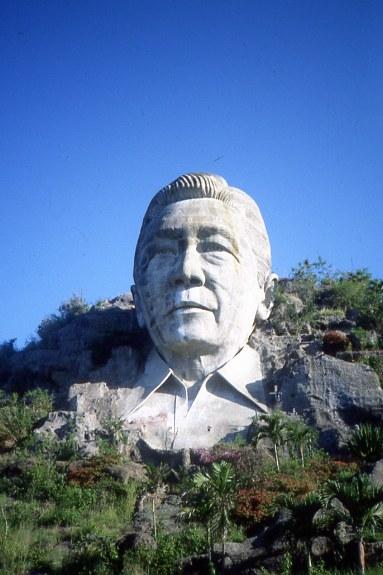
Bust of Ferdinand Marcos, the dictator who embezzled $10 billion. International creditors still collect payments from the people of the Philippines because of their loans to his corrupt regime.
After super typhoon Haiyan hit the Philippines, nations and charities were praised for their quick response. The United Kingdom offered more than $110 million in grants and humanitarian assistance, and the US promised $90.5 million. They did not offer to cancel debt payments.
In 2014 it is estimated that the Philippines will have to spend $8.8 billion on debt service, almost as much as the $8.99 billion it will spend on infrastructure projects and reconstruction.
After the disaster, financial support from international financial institutions like the World Bank and Asian Development Bank came mostly in the form of loans which will need to be repaid.
The Asian Development Bank offered more than $800 million in loans, compared with $23 million in grants.
The World Bank offered only new loans: $500 million for budget support, and $479 million for infrastructure investment, facilitating private investment, investments in human capital of the poor, and improving good governance and transparency.
Does the aid reach the poor?
The rapid inflow of aid sparked concerns that the money would not be used for its intended purpose. The Philippines is ranked 94th out of 177 for perceived corruption, according to Transparency International. There have recently been extra-judicial killings of activists and journalists, and the arbitrary imprisonment of activists opposing the political regime.
Responding to these concerns, the government announced that it has updated its Foreign Aid Transparency Hub website, which tracks aid promised to, and received by, government agencies.
Father Shay of the PREDA Foundation, a Philippine human rights and social development organization working with the poorest and most vulnerable in society, has concerns about whether aid money would get to those that need it. In an email interview, he wrote that his team in the Taboclan region has seen little improvement in the condition of the people in the months following the disaster.
“Grant aid, not new loans, is needed to overcome the impact of the tropical cyclone” said the independent expert appointed by the UN Human Rights Council, Dr Cephas Lumina, in a press release earlier in 2014. “The disaster should rather serve as an opportunity for lenders to acknowledge that odious debts emanating from the rule under Ferdinand Marcos should be cancelled.”
Deeply in debt, but not poor enough to have it cancelled
The Philippines is highly indebted, but the World Bank and IMF consider the country too wealthy to qualify for debt relief.
In an interview with the Asian Development Bank, President Benigno Aquino III said “as the government is still under deficit financing, balancing between disaster preparedness and other needs are obviously very difficult decisions, since we are fully aware of the opportunity costs of our choices.”
Rogier van den Brink, a Lead Economist at the World Bank, said that the World Bank conducted a debt sustainability analysis of the Philippines early in 2013 before the typhoon struck, and the results had not changed.
“The country’s debt level is expected to fall and will remain manageable,” he wrote me by email. “This trend reflects the country’s prudent macro and debt policies aimed at strengthening overall fiscal sustainability and management. The Bank reviewed this analysis for the emergency loan and found the assessment to remain valid.”
Activists do not agree with the World Bank’s conclusion that new loans will have limited impacts on the Philippines. “The reconstruction, development and realization of economic and social rights will be undermined if the high debt stock of the country is further augmented,” Dr Lumina said. “International lenders should rather consider canceling debt, to ensure that the country can recover.”
Reconstruction efforts are not profit generating activities, he said. “By definition, loans for reconstruction cannot generate returns to enable the debt to be paid.”



